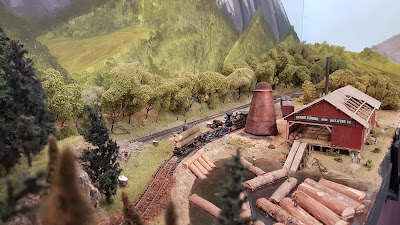Galen
Gallimore runs a great blog over at http://ocalicreek.blogspot.com/. Recently,
Galen made a thoughtful post titled "Whats the intent?". In turn, his
post had been inspired by a post on Mike Cougill's blog at
http://www.ostpubs.com/whats-the-intent/. Their posts explored the rationale behind
what we are trying to achieve with our model railroads. Galen issued a challenge for other modelers to share their thoughts about the intent behind their layouts so this is some of my thinking for my Thoroughfare Gap Railroad.
My decision to model the 1890's
was very intentional. From the outset, I intended for my railroad to be a
'window into the past', with a distinct focus on the connection that railroads
brought to communities.
Before the turn of the century, your own two feet
or a horse were the most common mode of transport and travelling 12 miles, or
20 kilometres by wagon was a big day. When the railroads arrived they more readily connected communities across the country. Journeys now took days rather than weeks or months and people
and goods traveled more freely than ever before. Railroads become vitally important in building local and national economies.
My layout attempts to build the sense of connection in three ways:
1. Point to
point design
The track is arranged like a real railroad in that the track
starts in one locality (Erewhon) and ends in another (Teresaton). The layout
has no continuous running. I took some time to come around to this idea as
every layout I had built featured continuous running and it was hard to
break with tradition. However, it opened up opportunities for operation and
scenery building which further add to the sense of connection.
2. Different scenery for different localities
 |
| The drier canyon contrasts with the green deciduous forest around Cass. This gives a sense these places are quite different localities. |
Changing the type of scenery for each
locality gives the impression the railroad covers vast distances. This was
mentioned in my track plan post where I mentioned the influences of John
Olsen's Mescal Lines and his colour mood technique.
I tried to
place the transitions so scenes change in a logical way. The drier canyon changes to long grass land, to deciduous forests to towering redwood forests,
to a snowy mountain pass. I have also made use of scenic barriers via ridges
and trees to create separate scenes.
 |
| The scenic variety can give the sense the railroad covers a vast distance. |
3. Scale people
A railroad does not just connect localities or industries, it connects people. People need
to travel from place to place and send and receive goods. In the 1890s, railroads were a key part of life and a larger portion of the population would interact directly with the railroad, either via passenger trains or sending and receiving the goods for their business, no matter how big or small.
My layout features
many HO scale figures, possibly more than average. I’m very lucky that my
father enjoys painting the figures and he is always generously finding new
period figures to go on the layout. One day I’ll do a post focusing on his work.
On the
Thoroughfare Gap Railroad, you will see passengers crowding the station
platforms, waiting for the next train. The team tracks are bustling with
workers and Teresaton’s main street is a hive of activity, the townsfolk
shopping for the latest wares brought in over the rails from somewhere far
away.
I feel the
presence of the figures gives face for the railroads connection. The railroad
isn’t just serving a set of industries; it is enable the people and their goods to travel to other places on the layout.
Overall my
intent was to demonstrate the important role played by railroads in connecting communities during the
1890s. I tried to achieve this by making the trains travel in a
point to point fashion through varied scenery and localities and making the people the railroad serves a principle modelling subject.
I’m
interested to hear what the intent behind your model railroad is. Leave me a comment with your thoughts or a
link to your blog post. If you haven’t yet built your model railroad, what are
you hoping to capture?







